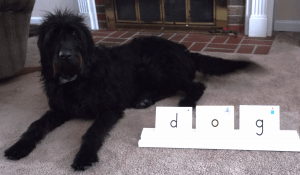Multisensory Monday- Extra Activities for Word Blending
Posted by Brainspring on 19th Apr 2015
 Hi everyone,
Hi everyone,
Welcome to Multisensory Monday! Over lunch, another RLAC instructor and I were talking about how much we love the 3 Part Drill and think it is the most important piece of Phonics First that a teacher can implement. I suggest that teachers use the 3 Part Drill multiple times a week in their classroom, especially for their struggling students. Since doing the exact same thing over and over again can cause even an engaging activity to lose its luster sometimes, so every once in a while I like to add a little sparkle in by changing things up.
How often are you able to do the 3 Part Drill with your students?
Spice Up the Blending Drill
 You can easily add some spice to the Blending Drill to keep your students’ interest piqued on days when the drill is feeling a little bland. You don’t want to use these additions every time because the drill is designed to be quick, efficient and build automaticity. Occasionally trying one of the modifications though will keep your students interested and make them think deeper than usual during the Blending Drill.
You can easily add some spice to the Blending Drill to keep your students’ interest piqued on days when the drill is feeling a little bland. You don’t want to use these additions every time because the drill is designed to be quick, efficient and build automaticity. Occasionally trying one of the modifications though will keep your students interested and make them think deeper than usual during the Blending Drill.
- Real or Nonsense?
- This addition is best for young students K-1. After blending a syllable on the blending board, the students have to decide if the word is a real word or a nonsense word. If it is a real word, ask for a volunteer to use it in a sentence. To prevent students from shouting out on top of each other, have them signal if it is a real or nonsense word with some kind of gesture, such as a thumbs-up or thumbs-down.
- Real Word Brainstorm
- Use this modification as a challenge for older students. If the syllable on the blending board is not a real word, ask the students to think of real words that syllable is a part of. Take the syllable “mag” for example. It’s not a word on its own, but it is part of many words, like “magnet,” “magazine,” and “imagine”. I love this addition because it emphasizes why we use nonsense syllables for the blending drill: they can be part of real words, or could even be a real word that the student hasn’t heard before.
- If Only…
- This modification can work for students at any level, except very beginning readers. If the syllable on the blending board is not a real word, ask the students if there is a letter that could be changed to make a real word. The students respond by saying “If only the…was a … Then the word would be…” For example, if the syllable was “tun,” a student could say, “If only the n was a b. Then the word would be tub.”
Share your ideas for keeping students engaged in the Blending Drill in the comments below!
Apps for Phonemic Awareness
Teachers ask me all the time for apps and games their students can use to support what they are learning in phonics. Thanks to Dite’s post today, now I have a list of apps that work well to complement phonological awareness skills students are working on! See the list of apps Dite personally uses on her blog.
Next time I have babysitting duty, I’m trying out ABC Magic 6 Sound Beginnings!
Remember to like us on FB, follow us on Twitter and share us with your friends.
